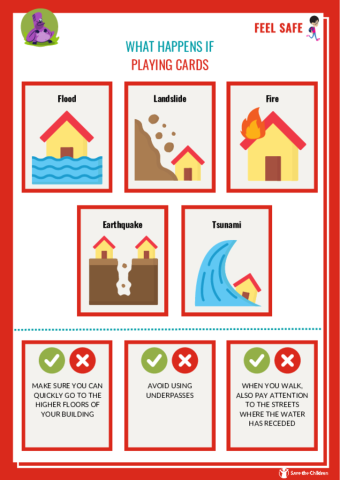What happens if
Objectives
- Get to know the correct behaviour in case of an emergency.
- Stimulate creativity and problem solving
STEP BY STEP
BEFORE STARTING
The teacher begins by asking the class to share any calamities they are familiar with. To stimulate discussion, the teacher may mention examples such as earthquakes, floods, landslides, tsunamis, and fires.
ILLUSTRATED CARDS
Students are tasked with creating illustrated cards for each of the listed calamities. It's important to use sturdy cardstock and to draw clearly, as these cards will be used later in the activity. Each student can interpret the event in their own way; for instance, they might draw a wave to represent a tsunami or a crack in the ground for an earthquake Sudden ground shaking resulting from movements of the earth’s crust . Alternatively, they can use the cards provided (see attached "What Happens If - Playing Cards" below).
LET'S PLAY!
The class is divided into small groups. Each group selects one of the illustrated events or cards and creates two lists: one for appropriate behaviours and another for behaviours to avoid during that event.
The teacher provides examples of correct and incorrect behaviors (see attached "What Happens If - Playing Cards" below) to assist them in the list creation.
CONCLUDING THOUGHTS
The teacher compiles all the correct behaviors associated with each calamity on the board and facilitates a discussion comparing prior knowledge to what students learned during the activity. To encourage reflection, the teacher poses the following questions:
- Did you know all of these behaviors?
- Were there any behaviors that surprised you?
- Do you have any additional suggestions?

Add new comment